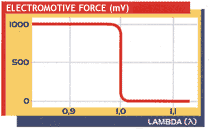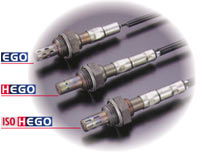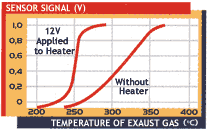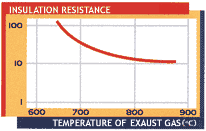|
An important characteristic of the zirconium element is that it
becomes conductor of oxygen ions a temperature above of
300°C, generating an electrical voltage. This electrical
voltage is generated will have a difference in the
oxygen concentration between the internal and the
external of the element. An eletrical voltage near the
zero is generated if the air-fuel mixture will be lean
( > 1) and
an eletrical voltage near the 1V ( > 1) and
an eletrical voltage near the 1V ( < 1) if it will be rich. < 1) if it will be rich.

When
the air-fuel mixture nears the ideal ratio ( = 1), there is
a sharp change in the generated voltage, from 0 to 1V. = 1), there is
a sharp change in the generated voltage, from 0 to 1V.
The
ECU uses the voltage produced by the Lambda Sensor to instruct the
mixture system to control the fuel mixture.
Since the element only produces voltage when the element is above 300°C,
the exhaust gas take some time to heat the element to the necessary
temperature, after the engine is running. To reduce the time before
the sensor begins functioning, many sensors today have an internal
ceramic heater. These sensors have three or four conductive wires.
NTK ceramic heaters rely on our extensive experience and ensure
high performance and reliability .
Zirconium
Exhaust Oxygen Sensor 
This
sensor is highly reliable, even in conditions of extreme
use. Has rapid response and is compact.
| 
|
Heated
Zirconium Exhaust Oxygen Sensor 
A
ceramic heater is inserted into the sensor and heat its interior,
allowing that it can be use at a wide range of temperatures of exhaust gas.
Because the ceramic heater, the beginning of functioning is
more quickly than the EGO type (withou ceramic heater)
and has a lesser variation of its characteristics.

Heated
Zirconium and Insulated Element Exhaust Oxygen Sensor
This
sensor has an additional wire to the compound signal in
relation to the conventional sensor with ceramic heater(HEGO). The stability of this signal
is guaranteed by the complete insulation between the sensor element
and the external metal casing, beyond to a special
projected ceramics. This guarantees greater useful life the sensor, therefore it eliminates possible imperfections proceeding from oxidation between the exhaust pipe and the sensor.

|



